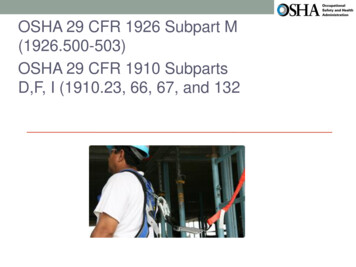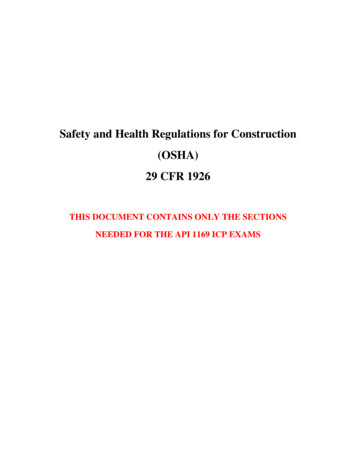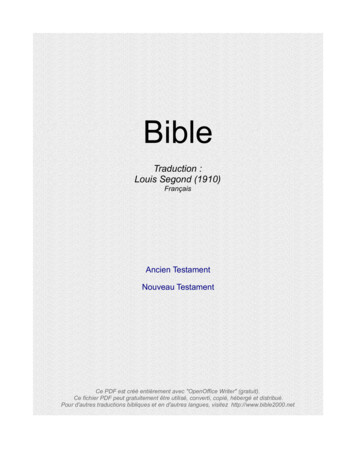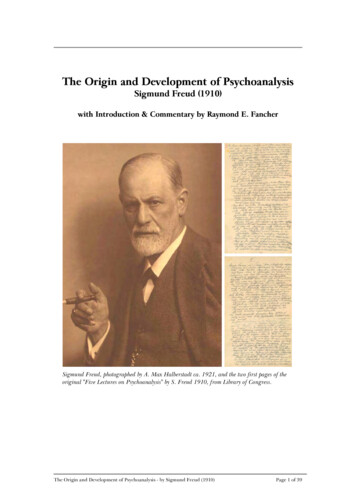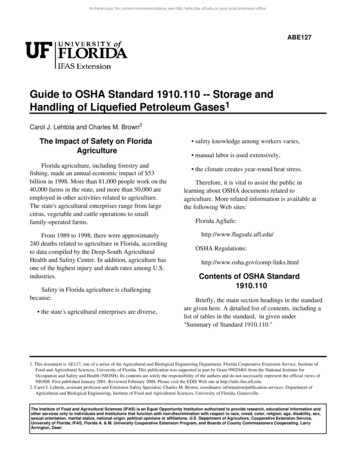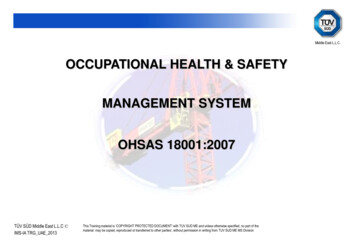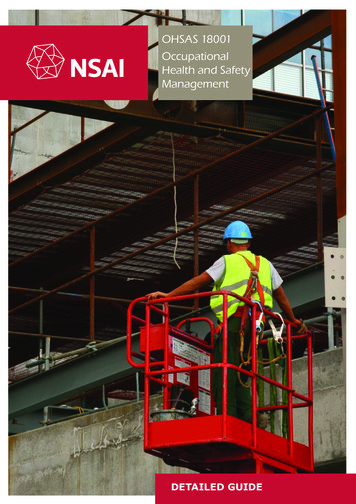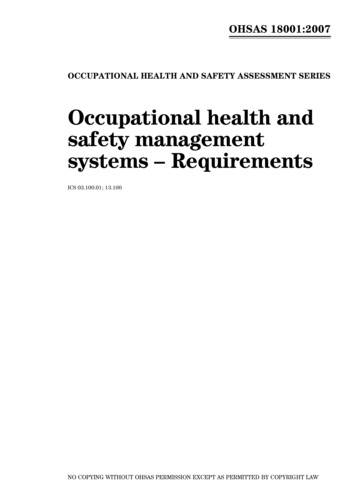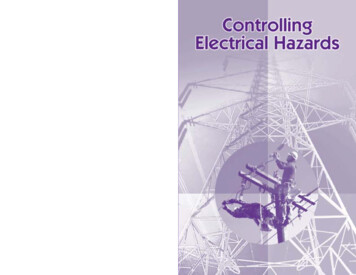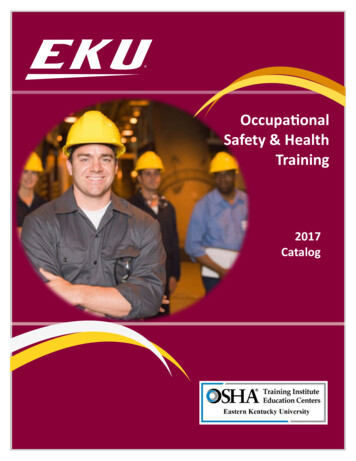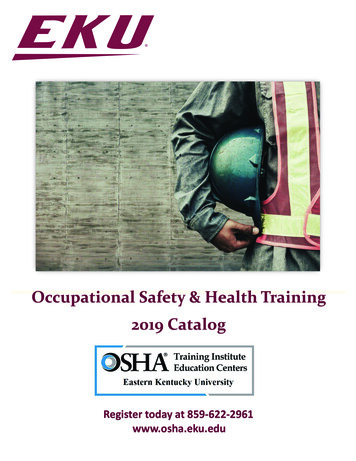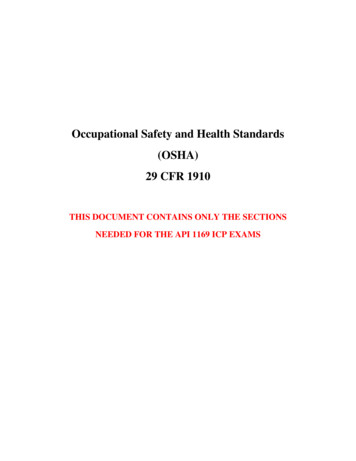
Transcription
Occupational Safety and Health Standards(OSHA)29 CFR 1910THIS DOCUMENT CONTAINS ONLY THE SECTIONSNEEDED FOR THE API 1169 ICP EXAMS
SectionsSubpart H—Hazardous Materials§1910.119 Process safety management of highly hazardous chemicals.APPENDIX A TO §1910.119—LIST OF HIGHLY HAZARDOUS CHEMICALS, TOXICS AND REACTIVES(MANDATORY)APPENDIX B TO §1910.119—BLOCK FLOW DIAGRAM AND SIMPLIFIED PROCESS FLOW DIAGRAM(NONMANDATORY)APPENDIX C TO §1910.119—COMPLIANCE GUIDELINES AND RECOMMENDATIONS FOR PROCESS SAFETYMANAGEMENT (NONMANDATORY)APPENDIX D TO §1910.119—SOURCES OF FURTHER INFORMATION (NONMANDATORY)Subpart I—Personal Protective Equipment§1910.132 General requirements.§1910.133 Eye and face protection.§1910.134 Respiratory protection.APPENDIX A TO §1910.134—FIT TESTING PROCEDURES (MANDATORY)APPENDIX B-1 TO §1910.134: USER SEAL CHECK PROCEDURES (MANDATORY)APPENDIX B-2 TO §1910.134: RESPIRATOR CLEANING PROCEDURES (MANDATORY)APPENDIX C TO §1910.134: OSHA RESPIRATOR MEDICAL EVALUATION QUESTIONNAIRE (MANDATORY)APPENDIX D TO §1910.134 (MANDATORY) INFORMATION FOR EMPLOYEES USING RESPIRATORS WHENNOT REQUIRED UNDER THE STANDARD§1910.135 Head protection.§1910.136 Foot protection.§1910.137 Electrical protective equipment.§1910.138 Hand protection.Subpart J—General Environmental Controls§1910.145 Specifications for accident prevention signs and tags.§1910.146 Permit-required confined spaces.§1910.147 The control of hazardous energy (lockout/tagout).Subpart N—Materials Handling and Storage§1910.184 Slings.
29 CFR 1910 (OSHA)Subpart H—Hazardous MaterialsAUTHORITY: Sections 4, 6, and 8 of the Occupational Safety and Health Act of 1970 (29 U.S.C.653, 655, 657); Secretary of Labor's Order No. 12-71 (36 FR 8754), 8-76 (41 FR 25059), 9-83 (48 FR35736), 1-90 (55 FR 9033), 6-96 (62 FR 111), 3-2000 (65 FR 50017), or 5-2007 (72 FR 31159), 4-2010(75 FR 55355) or 1-2012 (77 FR 3912), as applicable; and 29 CFR part 1911.Sections 1910.103, 1910.106 through 1910.111, and 1910.119, 1910.120, and 1910.122 through1910.126 also issued under 29 CFR part 1911.Section 1910.119 also issued under Section 304, Clean Air Act Amendments of 1990 (Pub. L. 101549), reprinted at 29 U.S.C.A. 655 Note.Section 1910.120 also issued under Section 126, Superfund Amendments and Reauthorization Actof 1986 as amended (29 U.S.C.A. 655 Note), and 5 U.S.C. 553.§1910.119 Process safety management of highly hazardous chemicals.Purpose. This section contains requirements for preventing or minimizing the consequences ofcatastrophic releases of toxic, reactive, flammable, or explosive chemicals. These releases may result intoxic, fire or explosion hazards.(a) Application. (1) This section applies to the following:(i) A process which involves a chemical at or above the specified threshold quantities listed inappendix A to this section;(ii) A process which involves a Category 1 flammable gas (as defined in 1910.1200(c)) or aflammable liquid with a flashpoint below 100 F (37.8 C) on site in one location, in a quantity of 10,000pounds (4535.9 kg) or more except for:(A) Hydrocarbon fuels used solely for workplace consumption as a fuel (e.g., propane used forcomfort heating, gasoline for vehicle refueling), if such fuels are not a part of a process containinganother highly hazardous chemical covered by this standard;(B) Flammable liquids with a flashpoint below 100 F (37.8 C) stored in atmospheric tanks ortransferred which are kept below their normal boiling point without benefit of chilling or refrigeration.(2) This section does not apply to:(i) Retail facilities;(ii) Oil or gas well drilling or servicing operations; or,(iii) Normally unoccupied remote facilities.(b) Definitions. Atmospheric tank means a storage tank which has been designed to operate atpressures from atmospheric through 0.5 p.s.i.g. (pounds per square inch gauge, 3.45 Kpa).1
29 CFR 1910 (OSHA)Boiling point means the boiling point of a liquid at a pressure of 14.7 pounds per square inchabsolute (p.s.i.a.) (760 mm.). For the purposes of this section, where an accurate boiling point isunavailable for the material in question, or for mixtures which do not have a constant boiling point, the 10percent point of a distillation performed in accordance with the Standard Method of Test for Distillationof Petroleum Products, ASTM D-86-62, which is incorporated by reference as specified in §1910.6, maybe used as the boiling point of the liquid.Catastrophic release means a major uncontrolled emission, fire, or explosion, involving one or morehighly hazardous chemicals, that presents serious danger to employees in the workplace.Facility means the buildings, containers or equipment which contain a process.Highly hazardous chemical means a substance possessing toxic, reactive, flammable, or explosiveproperties and specified by paragraph (a)(1) of this section.Hot work means work involving electric or gas welding, cutting, brazing, or similar flame or sparkproducing operations.Normally unoccupied remote facility means a facility which is operated, maintained or serviced byemployees who visit the facility only periodically to check its operation and to perform necessaryoperating or maintenance tasks. No employees are permanently stationed at the facility.Facilities meeting this definition are not contiguous with, and must be geographically remote fromall other buildings, processes or persons.Process means any activity involving a highly hazardous chemical including any use, storage,manufacturing, handling, or the on-site movement of such chemicals, or combination of these activities.For purposes of this definition, any group of vessels which are interconnected and separate vessels whichare located such that a highly hazardous chemical could be involved in a potential release shall beconsidered a single process.Replacement in kind means a replacement which satisfies the design specification.Trade secret means any confidential formula, pattern, process, device, information or compilation ofinformation that is used in an employer's business, and that gives the employer an opportunity to obtainan advantage over competitors who do not know or use it. See Appendix E to §1910.1200—Definition ofa Trade Secret (which sets out the criteria to be used in evaluating trade secrets).(c) Employee participation. (1) Employers shall develop a written plan of action regarding theimplementation of the employee participation required by this paragraph.(2) Employers shall consult with employees and their representatives on the conduct anddevelopment of process hazards analyses and on the development of the other elements of process safetymanagement in this standard.(3) Employers shall provide to employees and their representatives access to process hazardanalyses and to all other information required to be developed under this standard.2
29 CFR 1910 (OSHA)(d) Process safety information. In accordance with the schedule set forth in paragraph (e)(1) of thissection, the employer shall complete a compilation of written process safety information beforeconducting any process hazard analysis required by the standard. The compilation of written processsafety information is to enable the employer and the employees involved in operating the process toidentify and understand the hazards posed by those processes involving highly hazardous chemicals. Thisprocess safety information shall include information pertaining to the hazards of the highly hazardouschemicals used or produced by the process, information pertaining to the technology of the process, andinformation pertaining to the equipment in the process.(1) Information pertaining to the hazards of the highly hazardous chemicals in the process. Thisinformation shall consist of at least the following:(i) Toxicity information;(ii) Permissible exposure limits;(iii) Physical data;(iv) Reactivity data:(v) Corrosivity data;(vi) Thermal and chemical stability data; and(vii) Hazardous effects of inadvertent mixing of different materials that could foreseeably occur.NOTE: Safety data sheets meeting the requirements of 29 CFR 1910.1200(g) may be used to complywith this requirement to the extent they contain the information required by this subparagraph.(2) Information pertaining to the technology of the process. (i) Information concerning thetechnology of the process shall include at least the following:(A) A block flow diagram or simplified process flow diagram (see appendix B to this section);(B) Process chemistry;(C) Maximum intended inventory;(D) Safe upper and lower limits for such items as temperatures, pressures, flows or compositions;and,(E) An evaluation of the consequences of deviations, including those affecting the safety and healthof employees.(ii) Where the original technical information no longer exists, such information may be developed inconjunction with the process hazard analysis in sufficient detail to support the analysis.(3) Information pertaining to the equipment in the process. (i) Information pertaining to theequipment in the process shall include:3
29 CFR 1910 (OSHA)(A) Materials of construction;(B) Piping and instrument diagrams (P&ID's);(C) Electrical classification;(D) Relief system design and design basis;(E) Ventilation system design;(F) Design codes and standards employed;(G) Material and energy balances for processes built after May 26, 1992; and,(H) Safety systems (e.g. interlocks, detection or suppression systems).(ii) The employer shall document that equipment complies with recognized and generally acceptedgood engineering practices.(iii) For existing equipment designed and constructed in accordance with codes, standards, orpractices that are no longer in general use, the employer shall determine and document that the equipmentis designed, maintained, inspected, tested, and operating in a safe manner.(e) Process hazard analysis. (1) The employer shall perform an initial process hazard analysis(hazard evaluation) on processes covered by this standard. The process hazard analysis shall beappropriate to the complexity of the process and shall identify, evaluate, and control the hazards involvedin the process. Employers shall determine and document the priority order for conducting process hazardanalyses based on a rationale which includes such considerations as extent of the process hazards, numberof potentially affected employees, age of the process, and operating history of the process. The processhazard analysis shall be conducted as soon as possible, but not later than the following schedule:(i) No less than 25 percent of the initial process hazards analyses shall be completed by May 26,1994;(ii) No less than 50 percent of the initial process hazards analyses shall be completed by May 26,1995;(iii) No less than 75 percent of the initial process hazards analyses shall be completed by May 26,1996;(iv) All initial process hazards analyses shall be completed by May 26, 1997.(v) Process hazards analyses completed after May 26, 1987 which meet the requirements of thisparagraph are acceptable as initial process hazards analyses. These process hazard analyses shall beupdated and revalidated, based on their completion date, in accordance with paragraph (e)(6) of thissection.(2) The employer shall use one or more of the following methodologies that are appropriate todetermine and evaluate the hazards of the process being analyzed.4
29 CFR 1910 (OSHA)(i) What-If;(ii) Checklist;(iii) What-If/Checklist;(iv) Hazard and Operability Study (HAZOP):(v) Failure Mode and Effects Analysis (FMEA);(vi) Fault Tree Analysis; or(vii) An appropriate equivalent methodology.(3) The process hazard analysis shall address:(i) The hazards of the process;(ii) The identification of any previous incident which had a likely potential for catastrophicconsequences in the workplace;(iii) Engineering and administrative controls applicable to the hazards and their interrelationshipssuch as appropriate application of detection methodologies to provide early warning of releases.(Acceptable detection methods might include process monitoring and control instrumentation withalarms, and detection hardware such as hydrocarbon sensors.);(iv) Consequences of failure of engineering and administrative controls;(v) Facility siting;(vi) Human factors; and(vii) A qualitative evaluation of a range of the possible safety and health effects of failure of controlson employees in the workplace.(4) The process hazard analysis shall be performed by a team with expertise in engineering andprocess operations, and the team shall include at least one employee who has experience and knowledgespecific to the process being evaluated. Also, one member of the team must be knowledgeable in thespecific process hazard analysis methodology being used.(5) The employer shall establish a system to promptly address the team's findings andrecommendations; assure that the recommendations are resolved in a timely manner and that theresolution is documented; document what actions are to be taken; complete actions as soon as possible;develop a written schedule of when these actions are to be completed; communicate the actions tooperating, maintenance and other employees whose work assignments are in the process and who may beaffected by the recommendations or actions.5
29 CFR 1910 (OSHA)(6) At least every five (5) years after the completion of the initial process hazard analysis, theprocess hazard analysis shall be updated and revalidated by a team meeting the requirements in paragraph(e)(4) of this section, to assure that the process hazard analysis is consistent with the current process.(7) Employers shall retain process hazards analyses and updates or revalidations for each processcovered by this section, as well as the documented resolution of recommendations described in paragraph(e)(5) of this section for the life of the process.(f) Operating procedures (1) The employer shall develop and implement written operatingprocedures that provide clear inst
29 CFR 1910 (OSHA) 2 Boiling point means the boiling point of a liquid at a pressure of 14.7 pounds per square inch absolute (p.s.i.a.) (760 mm.). For the purposes
